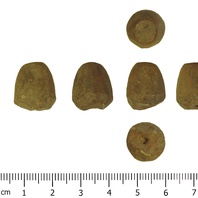
Viking Objects
Lead-Alloy Gaming Piece (DENO-7DABAC)
Lead gaming pieces like this one are a common find throughout the East Midlands, including the Torksey Viking camp. Gaming pieces would have been used to play games such as hnefatafl or Nine Men’s Morris, both of which are known to have been played by Scandinavians throughout the Viking diaspora.
Read More
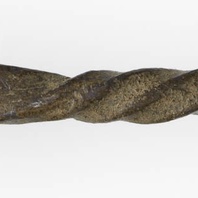
Viking Objects
Silver Ear Scoop Fragment (CM.1850-2008)
A fragment of a silver ear spoon or ear scoop with a body made from a spiral-twisted bar. Toilet articles like this were an important part of personal hygiene in the Viking Age. They were used to clean ear wax out of the ear and could be highly decorated to show off the user’s status.
Read More
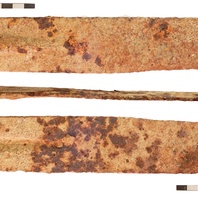
Viking Objects
Scythe (NLM-739C96)
Scythes such as this one would have been common agricultural implements. Dr Kevin Leahy comments that while the scythe has a similar shape to other early medieval examples, the lack of a typical bent tang leaves its dating in question.
Read More
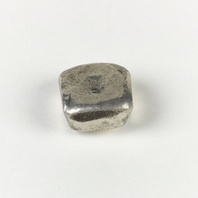
Viking Objects
Reproduction Square Weight
A square lead alloy weight based on one found in Nottinghamshire. It weighs 20g.
Read More
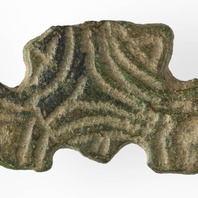
Viking Objects
Trefoil Brooch Fragment (CM.1823_2008)
A fragment of a Scandinavian copper-alloy trefoil brooch with a simple line pattern following its general outline. While of Scandinavian design, many examples found in the East Midlands were probably made in the Danelaw, and may have been copies of Scandinavian styles, instead of being imported from Scandinavia. For more information on Scandinavian jewellery in England check out our blog: Brooches, Pendants and Pins: Scandinavian Dress Accessories in England.
Read More
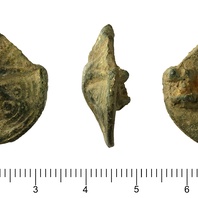
Viking Objects
Copper-Alloy Borre-Style Brooch (SWYOR-A257A6)
A Scandinavian copper-alloy Borre-style convex disc brooch decorated with three inward-looking Borre-style animal heads separated by wedge-shaped arms. Identified as Jansson type II A1 by Jane Kershaw. For more information on Scandinavian jewellery in England check out our blog: Brooches, Pendants and Pins: Scandinavian Dress Accessories in England.
Read More
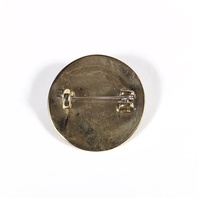
Viking Objects
Reproduction Silver Terslev Brooch
Terslev style, where Scandinavian ring-chain patterns are the main decorative component, is a subcategory of the Borre style and takes its name from the silver hoard discovered in Terslev, Denmark. The decoration comprises a series of ring-knots related to the Borre ring-chain. The Terslev style occurs mainly on brooches and pendants, including both high-quality gold and silver jewellery as well as lower-end base metal items. The cast-base metal jewellery, such as those made of copper alloy, were intended to imitate the higher-end gold and silver jewellery, and often employed techniques such as gilding to achieve this. The Terslev designs that occur in England extend the repertoire by introducing new Scandinavian motifs hitherto unrecorded in Scandinavia. For more information on Scandinavian jewellery in England check out our blog: Brooches, Pendants and Pins: Scandinavian Dress Accessories in England.
Read More
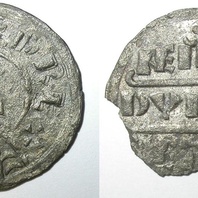
Viking Objects
Coin of Alfred the Great (1989-58/3381)
This silver penny from the mass grave at Repton was minted by a moneyer called Dudwine in Canterbury for Alfred the Great. Alfred was King of Wessex from 871 to 899 and spent most of his reign fighting off Viking invasions. He won a decisive victory at the Battle of Edington in 878 which resulted in a peace with the Vikings and the creation of the Danelaw. Minting coins was a way of controlling the means of exchange within a kingdom and which created a more easily administered standardized system of trade. Moreover, the coins themselves were often used as propaganda, portaying symbols and statements that gave off a desired message. The Vikings later used the minting of coins to legitimize their own rule.
Read More
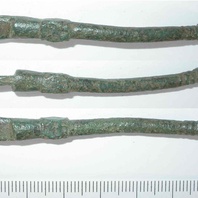
Viking Objects
Scale Arm Fragment (DENO-0619F7)
Folding balances of the type to which this arm belongs are known from the late Anglo-Saxon period and are quite common from the medieval period. The dating of this artefact is therefore somewhat problematic. Scales were a common commerical tool and would have been an important part of any exchange whether using a monetary system or a bullion system, such as the one that existed in Viking-occupied areas of England.
Read More
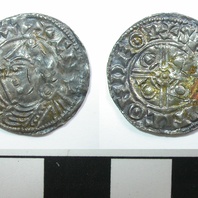
Viking Objects
Silver Penny (1960/459-2)
This silver penny was minted in Derby for King Cnut the Great, the Danish king who reigned over England from 1016-1035. It is not known precisely where it was found. Minting coins was a way of controlling the means of exchange within a kingdom and which created a more easily administered standardized system of trade. Moreover, the coins themselves were often used as propaganda, portaying symbols and statements that gave off a desired message. The Vikings later used the minting of coins to legitimize their own rule.
Read More
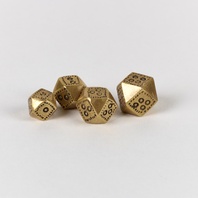
Viking Objects
Reproduction Polyhedral Weights
A group of four polyhedral weights of a type that is common throughout the Viking diaspora. This example has fourteen sides and four dots on each of the rectangular sides. These weights were adopted by the Vikings from Middle Eastern examples and appear to have become a de facto weight standard for traders.
